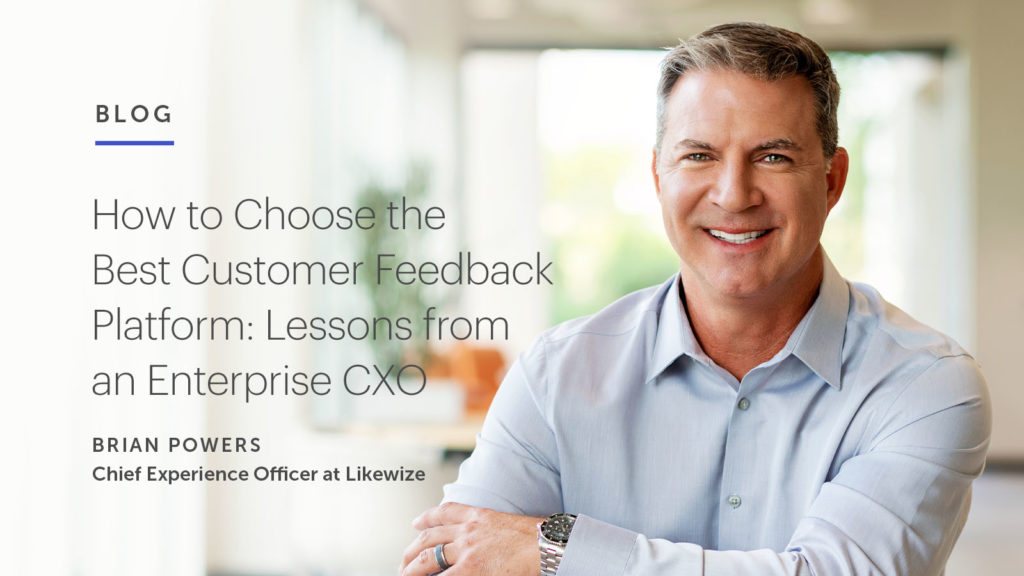Brian Powers, the chief experience officer at Likewize, shares his process and criteria for selecting the best customer feedback platform.
There’s no shortage of solutions today to help you obtain customer feedback, from very basic survey tools to sophisticated customer feedback management platforms. But with so many options, how do you decide what customer feedback tool is right for you?
We recently sat down with the Chief Experience Officer at Likewize (formerly Brightstar), Brian Powers, who shared his process and criteria for selecting the best customer feedback platform.
Identifying the Need for Change
Powers joined Likewize, a leading global provider of tech protection and support solutions, ready to dig right into his role by understanding the voice of the customer. Like many enterprise executives, he found a customer survey tool already in place when he started and anticipated that survey feedback would be a huge help.
Unfortunately, the feedback was lacking, as they only used static surveys consisting of 10 questions. Although it was a good starting point, it was difficult to understand the true voice of the customer without being able to dig deeper.
It was time for a change. But like every good leader, Powers knew he couldn’t make a purchase decision alone.
It Takes a Village
The decision to purchase a B2B technology solution in an enterprise today involves many stakeholders. Powers includes three key departments in the process.
Procurement is critical in the decision-making process, with final purchase authorization. Powers involves them up-front: “I educate procurement on which vendors we’re talking to and the problem that we’re trying to address with this particular RFP or vendor selection.” Partnering with procurement throughout the entire process, including negotiations, helps his team avoid redundant work.
Finance is another key partner. Since it will come out of the budget, they will ask for an ROI or business case.
Finally, Powers always involves the project management team a bit further in the buying journey to evaluate implementation complexity. This is essential since the actual cost of ownership may be higher than the quoted price if the solution is too complex to implement and taxing to manage.
3 Top Criteria for Selecting the Best Customer Feedback Platform
After using several customer feedback management solutions, Powers has three top criteria that never fail him. When evaluating solutions, he’s looking for:
- A flexible, self-service model. Powers recommends looking for vendors who have a flexible and robust self-service model that gives you the freedom to innovate, build unique solutions, and integrate with internal platforms. It’s also important to select vendors who are there to help you if you need it, and who have customer success support along the way, but empower you to do a lot of things yourself.
- Fast implementation. Along with flexibility, getting a solution up and running quickly is imperative. Powers checks references and reviews to understand how realistic the quoted speed of implementation is. In his experience, “Sometimes when you’re sold something, as a prospect you’re told ‘We’ll get it turned up very quickly,’ and then you’re a customer and you get in line and wait.’” In today’s fast-moving world of customer experience, delay is not an option.
- Best total cost of ownership (TCO). Powers puts together a complete TCO comparison of vendors to understand which solution ultimately provides the best value versus which may look the best on paper. He takes into consideration which modules they need currently and may need in the future, whether they’ll have to pay for customer success support and training, how much time his project management team will need to spend on implementation and management, and so on.
Powers’ needs go far beyond traditional customer surveys, though they do use email surveys. For example, they use text analytics to understand the sentiment in verbatim responses. They also deploy a mobile app survey to collect feedback through the app and website post-transaction. And they’re looking to add SMS next year.
To learn more about how Likewize (formerly Brightstar) chose the best customer feedback platform and accelerated growth with surveys, catch Brian in this fireside chat: Beyond Surveys: How to Get Ahead of Customer Expectations.







